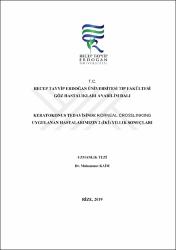| dc.description.abstract | Giriş ve Amaç: Keratokonus; korneanın öne doğru eğiminin arttığı ve inceldiği, dejeneratif, nonenflamatuvar, özellikle genç populasyonda ciddi görme bozukluğu ile karşımıza çıkan bir hastalıktır. Son zamanlarda teknolojideki yeniliklerle ve yapılan çalışmalarla hastalığın tedavisinde korneal kollajen çapraz bağlama (KÇB) yöntemi veya kollajen crosslinking (CCL) tedavisi artık sık olarak kullanılmaktadır. Çalışmamızın amacı, kollajen çapraz bağlama yönteminin etkinliğini, 2 yıl süreyle kliniğimizde yapılan takiplerle değerlendirmektir. Gereç ve Yöntem: Araştırmaya 01/01/2013-01/07/2016 arasında keratokonus tanısı biyomikroskopik, retinoskopik ve topografik bulgularla konulmuş ve progresyon gösteren; Amsler-Krumeich sınıflamasına göre evre 1-3 keratokonuslu, santral korneada derin skarı olmayan ve en ince pakimetrik değer ?400 olan kliniğimizde epi-on korneal kollajen çapraz bağlama yapılan 77 hastanın 111 gözü dahil edildi. Bulgular: Bu çalışmada, hastaların görme keskinliği takip sırasında anlamlı düzeyde iyileşti(p<0,001). Yüksek sıralı aberasyon(p=0,609), longitudinal sferik aberasyon (p=0,270), iridokorneal açı(p=0,143), kornea hacmi(p=0,068), korneanın en ince yerinin kalınlığı(p=0,638), kurvatur asimetrisi-ön değeri(p=0,370), kurvatur asimetrisi-arka değeri(p=0,358), AKb(p=0,719), KVf(p=0,366), KVb(p=0,206) ve keratokonus volümü(p=0,074) 2 yıllık takip sonunda başlangıca göre anlamlı değişikliğe uğramadı. Sonuç: Transepitelyal yöntemin keratokonusta iki yıllık takip sonuucunda progresyonu durdurduğu belirlenmiştir. Anahtar Sözcükler: Keratokonus, korneal çapraz bağlama, takip Introduction and Objectives: Keratoconus is a degenerative, noninfective disease with corneal changes like steepening and thinning. Corneal collagen crosslinking (CCL) therapy is widely used in the treatment of disease after recent technological innovations. The aim of our study was to evaluate the efficacy of the collagen cross-linking method in our clinic for 2 years. Materials and Methods: 111 eyes of 77 patients who were diagnosed with keratoconus by biomicroscopic, retinoscopic and topographical findings between 01/01/2013- 01/07/2016 were included in this study. Patients who had stage 1-3 keratoconus according to the Amsler-Krumeich classification, patients who had no deep scar in the central cornea and had the lowest pachymetric value ?400 were selected for corneal crosslinking. Results: In this study, visual acuity improved significantly during follow-up (p <0.001). High order aberration(p=0,609), longitudinal spherical aberration(p=0,270), iridocorneal angle(p=0,143), corneal volume(p=0,068), minimum korneal thickness(p=0,638), curvature asymmetry front(p=0,370), curvature asymmetry back(p=0,358), AKb(p= 0,719), KVf(p=0,366), KVb(p=0,206) and keratoconus volume(p=0,074) did not change significantly at the end of 2-year follow-up. Conclusion: The transepithelial method was found to halt progression during two years of follow-up. Keywords: Keratoconus, corneal crosslinking, follow up | en_US |


















